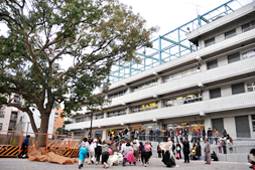 |
|
 |
Exterior of 3331 Arts Chiyoda, a former junior high school building
©3331 Arts Chiyoda |
|
|
|
3331 Arts Chiyoda is a hard-fought dream come true -- Japan's first community-based, multidisciplinary arts center. Newly opened in March, the center is located in a refurbished former junior high school in the heart of Tokyo's Chiyoda Ward, in an old downtown area near the city's famed Akihabara "Electric Town." With three floors, a basement and rooftop totaling about 9,000 square meters, the center includes a white-cube style gallery for art exhibitions along with a multipurpose community space; rental rooms prioritizing art universities, NPOs, community groups and commercial art galleries; a sports hall (the school's former gymnasium) for short-term events, performances and exhibitions; a large rooftop with enough space to accommodate communal vegetable gardening (with an emphasis on nutritional education) and athletic events; and a basement floor housing low-cost rental studios for both professional artists and the general public. Programs will include art exhibitions, artist residencies, creative workshops, symposiums, and art education classes taught by art professionals.
The focus is on collaboration, aimed at local residents and businesses in the ward. "We're not like a gallery collecting artwork," explains Mitsunori Sakano, communications director and one of the center's founders. "We're an artist-run organization, with the aim of building up creative ideas and exchanges at a local level."
But the center also encompasses an international vision. "We're hoping to become a cultural hub that builds a network with East Asian artist-run art communities in places like Taiwan, Singapore, Korea and Hong Kong," adds Sakano.
One intriguing project that involved both international and local collaboration was with media artist/curator Jun-jieh Wang of the newly launched Taipei Contemporary Art Center. Wang was invited to set up the Center's Tokyo branch at 3331 Arts Chiyoda since both art centers are artist/curator-run efforts. During the process, another participating artist from Taipei, Kuangyu Tsui, created a robot with the help of a local Akihabara company, Switch Science, that sells tools for DIY electronics. From this has come a program for local "scientists" with inventions combining engineering and art to show their wares in the 3331 Arts Chiyoda gallery space.
This unique art amalgam is the brainchild of Director Masato Nakamura. Dubbed a "social artist," Nakamura has been spearheading educational and community-focused art projects since 1997, when he established the nonprofit artists initiative Command N. Their first video art festival in Akihabara that year brought together an unprecedented group of artists, students and businesses from the famed electronics district. In tandem with Command N, Nakamura then founded the Kanda-based art gallery and studio Kandada in 2005. Their objective was to step out of the local Kanda and Akihabara communities with projects in greater Tokyo and the northern prefectures of Akita and Toyama, where Nakamura is from.
Unlike many community-focused organizations, 3331 Arts Chiyoda does not receive financial backing from the government. The center is run by Command A, a company set up and headed by Nakamura, with a Chiyoda Ward contract set for five years.
One of the highlights of 3331 Arts Chiyoda will be the first floor art gallery exhibitions. Now on show until May 23 are some impactful, abstract works by 82-year-old painter Kosei Sasaki. Titled "OK.PERFECT.YES," it is his first show in 40 years. Active in Japan's avant-garde art movements of the 1960s, Sasaki then left for New York City, where he lived and worked for 20 years. After returning to Japan in 1987 he chose a hermitic lifestyle, secluding himself from the art world, until recently. He now has a fresh, powerful body of work that stands as an inspiration for many -- young and old. "We chose Sasaki because we're not focusing on collecting art or the art market," explains Sakano. "Most galleries support artists ranging from young, emerging to established artists in their 40s or 50s. But we felt that an artist in his 80s could be very interesting. For us, Sasaki seems more like an art activist."
3331 Arts Chiyoda will positively impact both local and international communities. And like the traditional Japanese 3-3-3-1 handclap from which the name is gleaned, the pioneering art center is a resource for sharing, encouragement and achievement.
|